Multiplex RR EXTRA 330SC Gernot Bruckmann Limited Edition
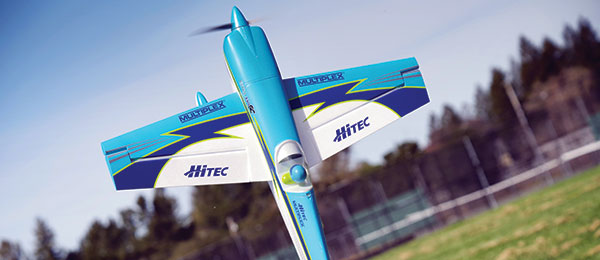
Written by Josh Bernstein Take your flying to the extreme Product review As seen in the June 2017 issue of Model Aviation.
Bonus video
Specifications
Model type: Electric 3-D/aerobatic Skill level: Intermediate to advanced Wingspan: 45.275 inches Wing area: 558 square inches Length: 47.25 inches Wing loading: 12.3 ounces per square foot Weight: 47.36 ounces Power system: Brushless electric outrunner Radio: Hitec Aurora 9X Construction: Elapor foam with plywood and carbon-fiber subframing Street price: $399.99Test-Model Details
Motor used: Multiplex 3520-0920 920 Kv brushless outrunner (included) Speed controller: Multiplex MULTIcont BL-55 S-BEC (included) Battery: Turnigy 3S 2,200 mAh 40C LiPo; Zippy Compact 3S 2,700 mAh 35C LiPo Propeller: APC 14 x 7 (included) Receiver: Hitec Optima six-channel 2.4 GHz receiver Servos: Four Hitec HS-82MG metal gear micro servos (included) Ready-to-fly weight: 48 ounces Flight duration: 4.5 to 6 minutesPluses
• Lightweight, rigid, and durable Elapor foam with internal plywood structure. • Wide flight envelope includes sport, precision, and aggressive 3-D. • Capable of advanced 3-D and extreme aerobatic maneuvers. • Excellent performance with included power kit.Minus
• Aggressive handling/transport might result in paint flaking off. So you’ve been spending too much time watching YouTube videos of the masterful Gernot Bruckmann, one of the world’s top RC pilots and designers, flying his gorgeous blue and white 41% EXTRA 330SC at some of the world’s top competitions. You’re salivating over the airplane’s clean lines, sharp color scheme, and brilliant flight characteristics, and just for a moment you dream of having one in your hangar. It’s a short moment, because you’re not in the mood to cash out your 401K (or kid’s college fund) to pay for it. Fear not! Gernot Bruckmann of GB Models has heard the pleas of countless fans, and has collaborated with the engineering wizards at Multiplex (and the design wizards at EXTRA Aircraft), and created an affordable, transportable, durable foam “mini-me” to his giant competition airplane. Multiplex sums up its motivation to release this 330SC simply, “… to give any and every model pilot the opportunity to fly a Gernot Bruckmann EXTRA 330SC.” Looking for all intents and purposes as if Gernot’s 3.1-meter behemoth was washed in hot water and thrown in the dryer for two hours, the Multiplex Receiver Ready (RR) EXTRA 330SC Gernot Bruckmann Limited Edition will soon hit your local hobby shop. Describing the airplane as an “Unlimited, freestyle 3-D monster,” Multiplex and Gernot have unabashedly thrown down the gauntlet. Many a company has thrown its hat into the ring with foam 3-D-capable airframes in the 1,200mm class, only to see its airplanes fall short of the requirements of hardcore 3-D/extreme aerobatic enthusiasts. Like many Multiplex models, this EXTRA 330SC will come in two versions: a kit version and RR. The former may be attractive for pilots who already own compatible components, while the latter provides not only a radically reduced purchase-to-flying time, but also a powertrain exhaustively tested by Multiplex and its stable of test pilots. Although the kit’s aggressive orange, yellow, and white color scheme will surely make visual orientation a breeze, the Gernot Bruckmann Limited Edition RR’s freakishly accurate-to-the-original, blue and white scheme is hard to pass up. Mirco Pecorari, EXTRA Aircraft’s graphic designer, developed the color scheme especially for the Gernot Bruckmann version.Construction
Because this review airplane is the RR version, much of the build process has been done at the factory. Multiplex claims a build time of 20 minutes and I found that to be accurate. All that is required to complete the build are a four-channel (minimum) receiver and battery packs. Servos are preinstalled along with most linkages, as are the motor and speed controller.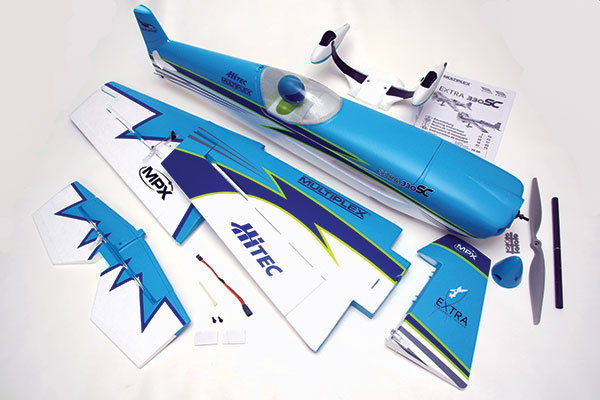
With many of the build steps completed before shipping, assembly can take as little as 20 minutes.
The two-part wing has been assembled (utilizing carbon-fiber spars embedded within the wing for extra rigidity). Multiplex’s use of a wing retention brace makes wing installation quick and easy. As is the case with many Multiplex models, Z-bends are used at the servo arms, with easy-to-adjust quick connects at the control surface horns. (This is particularly helpful when adjusting ailerons, if using a Y adapter into a single aileron receiver channel.) When it comes to servos, I was heartened to see that Multiplex chose the venerable Hitec HS-82MG. Considering this airplane’s size and weight, some manufacturers might have settled for the smaller HS-65MG servo. As this EXTRA 330SC was designed for more aggressive flight, with 47 ounce/inch of torque (at 6 volts) on hand, the HS-82MG should provide ample speed and power for aggressive tumbling. With improved electronics over its predecessor, the HS-81MG, accurate and consistent centering will enhance the 330SC’s precision characteristics. Regarding the RR version’s powertrain, Multiplex has chosen high-quality components as well. The MULTIcont BL-55 S-BEC speed controller handles two- to six-cell LiPo battery packs, while providing a consistent voltage to the receiver through its switch-mode BEC (preferable to linear BECs often found in smaller ESCs). In addition, the Permax 3520-920 Kv motor can swing the included 14 x 7 APC propeller on a 3S battery pack for nearly 500 watts.
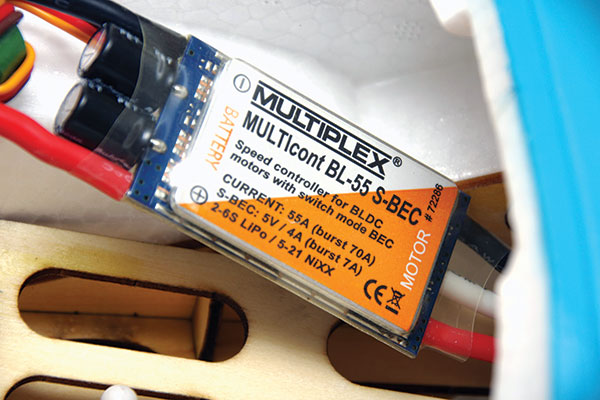
The MULTIcont BL-55 ESC provides fast throttle response, handles 70 amps of burst current, and utilizes the preferred switch-mode-style BEC.
Opening the airplane’s box, I was greeted with what I’ve come to expect from Multiplex—a perfectly packaged and protected airframe. Parts are separated, supported, covered, taped, and sealed. Tempted as you might be to start slashing away with a hobby knife, I suggest taking your time with scissors. X-Acto blades do not discriminate between packing foam and airplane foam. After all of the pieces were removed, I spent some time going over every item for signs of damage. Aside from a few places where paint had flaked off from rubbing on packing material, I found none. Because airplanes often travel through multiple climates on their way to your door, fluctuations in humidity could affect them. One of the benefits of Elapor foam is its ability to retain its original shape. Should you find a piece has developed a slight warp, simply bend it gently back, a little past neutral, and it will straighten itself out. Multiplex formats its manuals in a familiar pattern: written instructions (in paragraph form), followed by a complete parts list and illustrations that can be removed and laid out next to the text to provide visual context and guidance during assembly. The clear, straightforward text leaves little room for confusion. Here are a few recommendations for the building process. Elapor foam likes medium-viscosity CA adhesive, not epoxy or poly glues. During tail assembly, the rudder’s hinge pins are “snapped” into corresponding clips on the vertical stabilizer. The manual states that pressure should be applied until an audible snap is heard. If this occurs easily, that is great. If not, don’t force it because you could crush the foam. After a few attempts without success, I applied a small amount of silicone lubricant with a Q-tip to the pins, and presto!
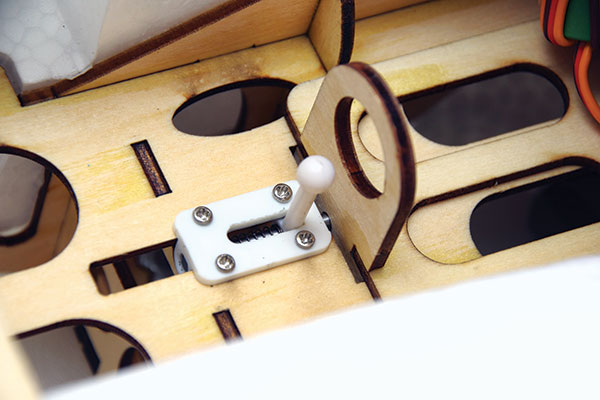
The unique, removable battery tray allows for quick pack changes and a consistent CG setting.
The aft handle of the EXTRA’s unique battery tray is stout, but likely won’t withstand harsh treatment. Pack changes should occur mindfully, and if necessary, a few extra drops of CA glue will ensure that it will hold up to repeated pack changes. The RR version’s ESC is left to float around the battery tray area. This will work fine, but pilots might want to use some of the supplied Velcro to anchor the speed controller. Should one be so inclined, the motor can be removed, the ESC wires unplugged, and then run beneath the battery tray. Multiplex provides control surface deflections for both low and high rates, as well as instructions for unlocking the airplane’s extreme flight capabilities. The aileron/elevator control horns must be slightly modified, bringing the attachment points closer to the control surface, and providing extreme 3-D levels of deflection. Recommended only for advanced pilots, this approach also requires cutting down the aileron/elevator control rods to avoid binding during extreme deflection.
Flying
After range testing, bind-free servo deflection checks, confirmation of proper center of gravity (CG), and propeller tightness, I selected my radio’s low rates (roughly 10° on elevator, 35° on rudder, and 20° on aileron), and taxied the EXTRA to the runway. The EXTRA’s tail wheel assembly maintains symmetry with the rudder without requiring adjustment. Tracking was excellent—even on a less-than-ideal surface. With the EXTRA’s main gear placement, I never felt a tendency to nose-over. Regarding batteries, Multiplex recommends a 3S 2,600 mAh LiPo battery pack. (A 2,200 mAh pack will work fine, although with reduced flight times.) Because I prefer to spend the first flight focusing on sport and precision maneuvers, I chose a larger 2,700 mAh 3S 35C pack to assist with tracking and stability at speed. The EXTRA’s unique, removable battery tray allowed for this flatter, wider pack without need for modification. Bringing power up smoothly, the big 14 x 7 APC-style propeller grabbed large scoops of air and the airplane was off the ground in the blink of an eye. I could tell immediately that power was not going to be a problem with this aggressive 3-D machine. After leveling off, I began trimming and testing for in-flight CG. Only a few clicks of trim were needed and, when the airplane was flying straight and level upright, I rolled it inverted. Aside from a slight fall to the nose (just slightly nose-heavy will provide the best balance of precise tracking, 3-D capability, and balloon-free landings), the airplane flew as well inverted as it did upright. After a few circuits, I eased into testing for knife-edge flight. Multiplex provides some starting numbers for mixing out the expected small amount of knife-edge coupling: 5% opposite aileron to rudder (“… when rudder is at full right, the ailerons deflect 5% to the left; when rudder is at full left, the ailerons deflect 5% to the right”), and 5% elevator to rudder (“… when rudder is at full right/left, the elevator deflects 5% up”). Each airplane will differ slightly (particularly with pitch coupling, because this is greatly affected by varying CG). I found these numbers put me well into the ballpark for couple-free knife-edge flight. (Because I prefer to use low rates for precision maneuvers, I subsequently increased my rudder’s low rate to maximum deflection, so less stick movement was required during knife-edge flight.) Having completed a proper setup, it was time to explore the EXTRA’s full flight envelope. With the heavier battery (and still on low rates), I put the airplane through its paces with sport and precision maneuvers. Despite its 3-D pedigree and given its longer tail moment (distance between balance point and tail), this 330SC tracks surprisingly well. The airplane felt at home with traditional aerobatics, knife-edge, point rolls, slow rolls, snaps, etc.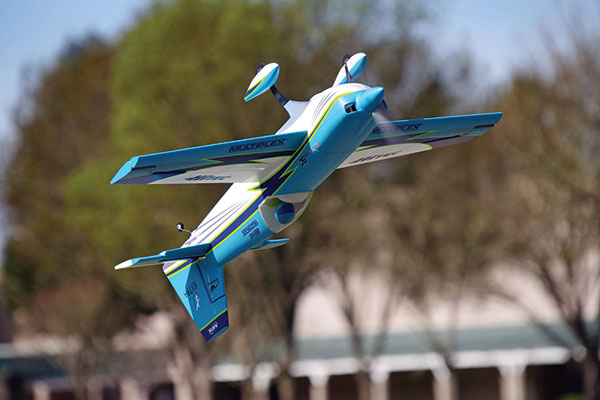
When flying maneuvers such as an inverted harrier, the EXTRA is surprisingly stable, displaying the composure of a larger airplane.
Regarding rolls, I offer a word of caution—even with reduced rates, this airplane rolls like a drill. In fact, on high rates, this is one of the fastest-rolling airplanes I’ve ever flown. Fortunately, the rolls are also impressively axial. I found the airplane welcomed quick rolls from/to upright, inverted, and knife-edge without losing composure. Snaps were clean and quick on low rates. Should you be game to try it, they were so fast on high rates that the timing required for a clean snap was more about intuition than actually seeing the wing come around. After exploring the EXTRA’s low-rate characteristics, it was time to pop in a lighter battery, switch the rates to high (maximum throws on all surfaces), and investigate Multiplex’s claims of 3-D superiority. With a 3S 2,200 mAh 40C LiPo battery pack placed approximately 1.5 inches forward from the battery tray’s rear handle, I punched the throttle from a standstill. With roughly 500 watts on tap (45 amps during bench testing), the 3-pound EXTRA shot off the ground. Continuing the vertical climbout, I eased off at approximately 200 feet, pushed the nose down, and transitioned into a knife-edge spin (a particularly violent maneuver). The airplane wrapped itself up in such a tight blur that I was left speechless. Easing out of the maneuver, I transitioned into an inverted harrier to test the small airplane’s post-stall characteristics. Having flown many foam 3-D-capable airplanes in this size, my common area of complaint is poor harrier performance. With some airplanes in this size range, wing rock is so pronounced that post-stall maneuvers sit on the sidelines. After spending a few minutes dancing between upright and inverted harriers, I was grinning from ear to ear. Although it is common that airplanes are more stable during inverted harriers (like a keel, stability is improved with the tail hanging down, allowing for unblocked, undisturbed airflow), I was impressed with how stable this little 330SC was below the stall speed. One of my favorite post-stall maneuvers involves driving the airplane toward myself in a low, inverted harrier then bringing the nose up into a hover only a few feet off the deck. After some hovering and torque rolls, I punch out for a few seconds, flip the airplane onto its back, and float back down in an inverted elevator (often called a Yo-Yo). This tests not only an airplane’s punch-out power, but also its composure transitioning into and out of a stalled state. Having flown some wood airplanes that struggle in this maneuver, I was heartened to see that the EXTRA seemed to savor the challenge. These are maneuvers on the advanced side of the spectrum; however, I have no doubt any intermediate and above 3-D-capable pilot will be comfortable with the airplane’s wide flight envelope. Moving on with 3-D testing, I spent some time in both higher-speed rifle rolls and lower-speed rolling harriers. Again, the EXTRA’s axial roll nature made both maneuvers not only easier on the pilot, but they also look impressive. With the airplane’s massive ailerons (and counter balances), high-alpha rolling harriers are possible at surprisingly low airspeeds.
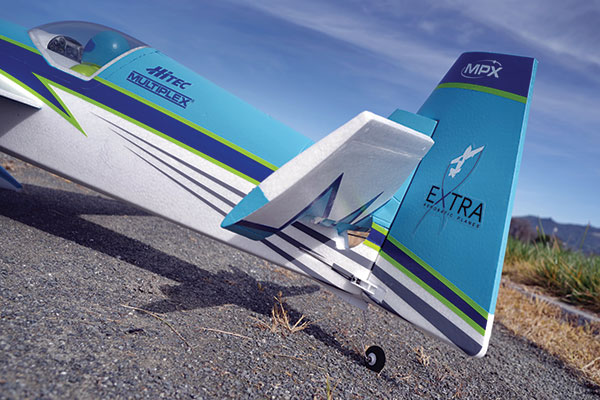
For an advanced pilot, Multiplex provides instructions for a control horn modification that will unlock the EXTRA’s extreme 3-D capabilities.
Starting with a fresh battery pack, it was finally time to transition into some serious, frame-bending, high-energy tumbling. This is where I expected the EXTRA to truly shine. Being lightweight, stiff as a board, and having massive control surfaces with tremendous deflections and power to spare, this airplane is the ultimate huckster. Build speed, bang the sticks, and hang on for dear life. Multiplex claims the aircraft saw upward of 18 Gs of force during testing. This EXTRA cries out to be tossed, thrown, and flung into every imaginable contortion. The RR version’s power package took everything I could throw at it and never got hot enough to worry. 3-D airplanes can be propped much higher because the throttle use is dynamic, and full power is rarely used for more than 10 seconds at a time. That said, not just any 920 Kv 120-gram motor can handle a 14 x 7 propeller at 3S without burning up. Concerning propellers, the 14 x 7 provides not only impressive pitch speed (allowing the EXTRA to build inertia into tumbles), but also a large diameter, providing excellent punch-out abilities and increased propwash benefiting post-stall maneuvers such as hovers and harriers. This is yet another sign that Multiplex takes its airplanes (and its claims) seriously. Additionally, the proven Hitec HS-82MG servos held up to the abuse, and I never felt any sign of blowback. Using the recommended 3S 2,600 mAh LiPo battery pack with an aggressive approach will give consistent 5-minute flights, although sport/traditional aerobatic flights can be stretched toward 7 minutes. If you use a smaller 3S 2,200 battery pack, aggressive flights will result in times between 4.25 and 4.5 minutes.










1 comments
Extra330sc
Add new comment